GPS is an acronym that stands for Global Positioning System. GPS is a space-based satellite navigation system that provides location and time information in all weather conditions, anywhere on or near the Earth’s surface. The U.S. Department of Defense developed and implemented this constellation of 24 satellites in 1978.
GPS stands for Global Positioning System. It is a satellite-based navigation system that provides accurate location and time information to users anywhere on or near the Earth’s surface. GPS has become an essential tool for many applications, including mapping, surveying, navigation, and search and rescue.

Credit: www.auto.com
What a Gps Means?
A GPS, or Global Positioning System, is a satellite-based navigation system that provides location and time information in all weather conditions, anywhere on or near the Earth’s surface.
The GPS system consists of three segments: the space segment, the control segment, and the user segment. The space segment is made up of a constellation of 24 satellites that orbit the Earth at an altitude of approximately 20,200 kilometers (12,550 miles).
The control segment consists of ground stations that track the satellites and keep them properly positioned in their orbits. The user segment is made up of GPS receivers that receive signals from the satellites and use those signals to calculate position, velocity, and time.
GPS receivers come in many different forms.
Some are stand-alone units designed for use in automobiles or boats; others are integrated into mobile phones or other portable devices; still others are part of larger systems used for surveying or aircraft navigation.
What Does Gps in a Car Stand For?
Most people know that GPS stands for Global Positioning System, but few know how this technology works or what it is used for. The Global Positioning System is a network of 24 satellites that orbit the earth. These satellites transmit signals to GPS receivers on the ground, which then use these signals to calculate their position.
GPS can be used for a variety of applications, including navigation, mapping, surveying, and timing. It is also often used in conjunction with other systems, such as the GLONASS (Global Navigation Satellite System) system operated by Russia.
Although GPS was originally developed for military applications, it is now widely available for civilian use.
In fact, many modern cars come equipped with GPS receivers, which can be used for a variety of purposes such as finding your way to your destination or locating nearby services such as gas stations or restaurants.
What are the 3 Types of Gps?
The three types of GPS are ground-based, satellite-based, and handheld. Ground-based GPS uses a network of 24 satellites that orbit the earth to provide accurate positioning information. Satellite-based GPS uses a single satellite to provide positioning information.
Handheld GPS devices use a combination of both ground-based and satellite-based GPS to provide accurate positioning information.
How Does the Gps Work?
The Global Positioning System (GPS) is a satellite-based navigation system made up of at least 24 satellites. GPS works in any weather conditions, anywhere in the world, 24 hours a day. The system provides accurate location and time information to users with GPS receivers.
How GPS Works
GPS receivers calculate their position by “triangulation”. Triangulation is a process of determining an object’s location by measuring angles to it from known points at either end of a fixed baseline.
In the case of GPS, the known points are GPS satellites high above the Earth. The receiver measures the distance to each satellite by timing how long it takes for signals from the satellite to reach the receiver. By comparing these distances with the known locations of the satellites, the receiver can calculate its own position on Earth.
Time is an important factor in triangulation because distance equals rate times time (or D = RT). If you know the time it takes for something to happen and you know how fast it happened, then you can determine how far away it took place. For example, if you know that it took two seconds for a car to travel from point A to point B and you know that cars normally travel at about 30 miles per hour, then you can conclude that point B was 60 miles from point A when the car started its journey.
This same principle applies to light waves and radio waves travelling through space – if we know how long it took for those waves to reach us, we can use that information to calculate how far away their source must have been when they were emitted. And this is precisely how GPS receivers work!
Each satellite continuously transmits signal data regarding its current position and precise time (using an atomic clock) back toward Earth at exactly the speed of light (186000 miles per second).
When this signal reaches a GPS receiver on or near Earth’s surface, several things happen almost instantaneously: 1) The receiver uses built-in electronics to lock onto this signal; 2) Once locked on, it starts timing how long it takes for each complete signal cycle (transmission plus reflection off of Earth back up into space) to arrive;
3) Based on this timing measurement and knowing exactly how fast radio waves travel through space (the speed of light),the receiver calculates precisely how far away each satellite must have been when its particular signal left that satellite;
What Does Gps Stand for in Geography
GPS is an acronym for Global Positioning System. This system uses a network of satellites to triangulate the position of a user on the earth’s surface. GPS can be used for navigation, mapping, surveying, and other purposes.
Conclusion
GPS stands for Global Positioning System. It is a satellite-based navigation system that provides location and time information in all weather conditions, anywhere on or near the Earth’s surface. GPS was originally developed for the military, but it is now used by civilians for a variety of purposes, including navigation, surveying, mapping, and timing.